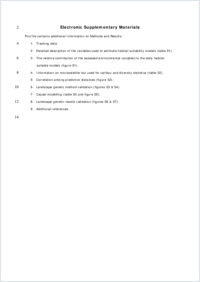Temporally dynamic habitat suitability predicts genetic relatedness among caribou
- Yannic, Glenn Caribou Ungava, Département de Biologie and Centre d'Etudes Nordiques, Université Laval, Québec, Canada - Institut de Biologie Intégrative et des Systèmes, Université Laval, Québec, Canada
- Pellissier, Loïc Department of Biology Unit of Ecology and Evolution, University of Fribourg, Switzerland
- Corre, Maël Le Caribou Ungava, Département de Biologie and Centre d'Etudes Nordiques, Université Laval, Québec, Canada
- Dussault, Christian Direction de la Faune Terrestre et de l'Avifaune, Ministère de l'Environnement, Québec, Canada
- Bernatchez, Louis Institut de Biologie Intégrative et des Systèmes, Université Laval, Québec, Canada
- Côté, Steeve D. Caribou Ungava, Département de Biologie and Centre d'Etudes Nordiques, Université Laval, Québec, Canada
-
10.07.2014
Published in:
- Proceedings of the Royal Society B: Biological Sciences. - 2014, vol. 281, no. 1792, p. 20140502
English
Landscape heterogeneity plays a central role in shaping ecological and evolutionary processes. While species utilization of the landscape is usually viewed as constant within a year, the spatial distribution of individuals is likely to vary in time in relation to particular seasonal needs. Understanding temporal variation in landscape use and genetic connectivity has direct conservation implications. Here, we modelled the daily use of the landscape by caribou in Quebec and Labrador, Canada and tested its ability to explain the genetic relatedness among individuals. We assessed habitat selection using locations of collared individuals in migratory herds and static occurrences from sedentary groups. Connectivity models based on habitat use outperformed a baseline isolation-by-distance model in explaining genetic relatedness, suggesting that variations in landscape features such as snow, vegetation productivity and land use modulate connectivity among populations. Connectivity surfaces derived from habitat use were the best predictors of genetic relatedness. The relationship between connectivity surface and genetic relatedness varied in time and peaked during the rutting period. Landscape permeability in the period of mate searching is especially important to allow gene flow among populations. Our study highlights the importance of considering temporal variations in habitat selection for optimizing connectivity across heterogeneous landscape and counter habitat fragmentation.
- Faculty
- Faculté des sciences et de médecine
- Department
- Département de Biologie
- Language
-
- English
- Classification
- Biological sciences
- License
-
License undefined
- Identifiers
-
- RERO DOC 211373
- DOI 10.1098/rspb.2014.0502
- Persistent URL
- https://folia.unifr.ch/unifr/documents/303863
Other files
Statistics
Document views: 133
File downloads:
- pdf: 163
- Supplementary material: 126

